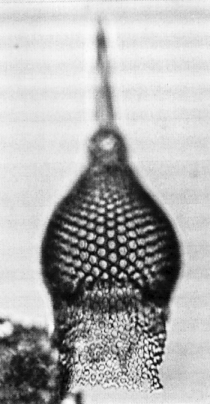 Calocycletta
(Calocyclior) caepa Moore
Calocycletta
(Calocyclior) caepa Moore Calocycletta
(Calocyclior) caepa Moore
Calocycletta
(Calocyclior) caepa MooreCalocycletta caepa Moore, 1972, p.150, pl.2, figs.4-7
Cephalis ovate, lobed, with sparse circular to subcircular pores and bearing a conical (early forms) to slightly bladed (late forms) apical horn. Thorax subspherical to campanulate, with circular pores hexagonally arranged and longitudinally aligned. External lumbar stricture absent in early forms but distinct in late forms. Abdomen lighter and more delicate than thorax, cylindrical in shape, containing subcircular to circular pores that may show longitudinal alignment and hexagonal arrangement (early forms). Late forms may have a very light, very irregularly pored abdomen that appears almost spongy. Abdomen terminates in five to fourteen triangular or spike-shaped feet that are usually very short and irregularly spaced (Moore, 1972).
Based on 30 specimens. Length of apical horn 62-130 µm, of cephalis 34-43 µm, of thorax 62-110 µm, of abdomen 43-158 µm, of feet 5-14 µm. Breadth of cephalis 34-43 µm, of thorax 101-134 µm, of abdomen (distally) 58-101 µm (Moore, 1972).
Only if the abdomen and terminal feet are preserved can early forms of C. caepa be distinguished from C. virginis and C. serrata. The bladed apical horn, campanulate thorax and very delicate abdomen of later forms aid in their distinction (Moore, 1972).
This species is present in middle to late Miocene sediments from the tropical Pacific Ocean, but is essentially absent from Indian Ocean sediments. Its morphotypic first appearance is within the Stichocorys wolffii Zone and it became extinct within the Stichocorys peregrina Zone.
C. caepa evolved from Calocycletta virginis near the early to middle Miocene boundary and continued on into the late Miocene. It left no descendants.
For generic level phylogeny see Sanfilippo and Riedel, 1992, p.31.